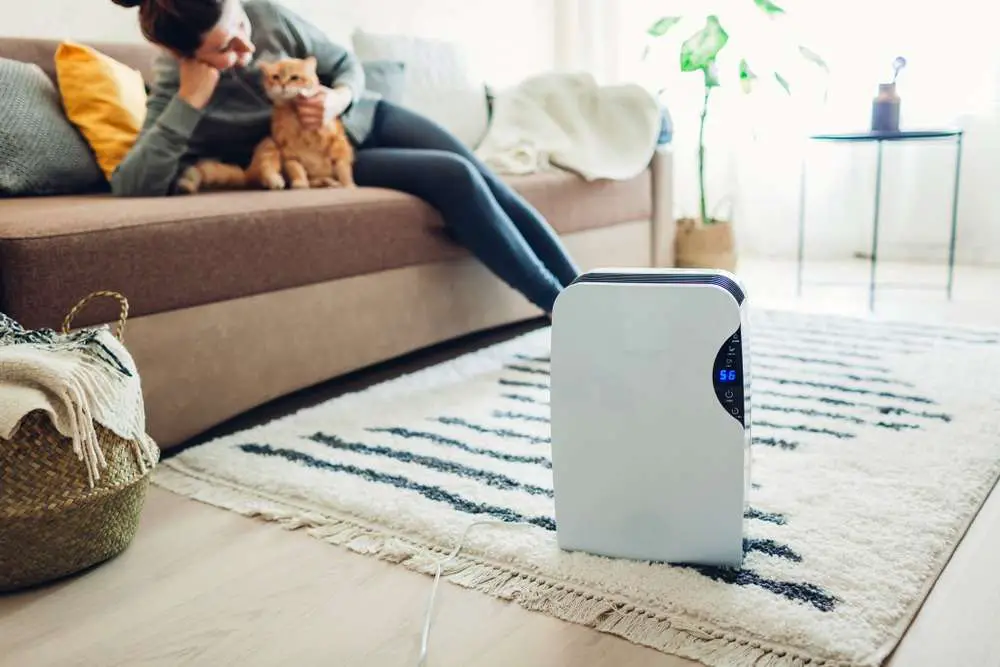- You are here:
- Home »
- Blog »
- Mold Advice »
- Can a Dehumidifier Spread Mold? 6 Frequently Asked Questions Answered
Can a Dehumidifier Spread Mold? 6 Frequently Asked Questions Answered

Dehumidifiers are becoming a staple in homes. They help control humidity by absorbing moisture from the air. For individuals with chronic obstructive pulmonary disease (COPD) and asthma, it relieves symptoms and makes breathing easier. Yet, many homeowners still have questions about the device. Such as, can a dehumidifier spread mold?
Dehumidifiers typically prevent mold but can spread them too. The device is not immune to the fungus, as it contains water in a closed, compact space. Without regular maintenance, mold will start to grow in the unit. And once it does, it will spread through the air that flows out of the device.
Table of contents
- Question 1: Can a dehumidifier spread mold?
- Question 2: How much water should a dehumidifier collect in a day?
- Question 3: How much does it cost to run a dehumidifier?
- Question 4: Can a dehumidifier be used as a heater?
- Question 5: How many amps does a dehumidifier draw?
- Question 6: How fast does a dehumidifier work?
- Final Thoughts
In this article, we will look at how a dehumidifier spreads mold and answer the following questions:
- How much water should a dehumidifier collect in a day?
- How much does it cost to run a dehumidifier?
- Can a dehumidifier be used as a heater?
- How many amps does a dehumidifier draw?
- How fast does a dehumidifier work?
The answer to these questions will help you understand the device. So, you can determine if you should get one for your home.
Question 1: Can a dehumidifier spread mold?
You’ve probably heard that dehumidifiers prevent mold, and that is true. It absorbs moisture from the air, making it difficult for the fungus to grow.
But, without maintenance, dehumidifiers can develop mold. The device stores the water it absorbs from the air. If you don’t drain or clean the tank regularly, mold, such as black mold, will start to form. The fungus will then spread into other parts of the device.
Eventually, mold particles will also spread through the air cycled out of the dehumidifier. The fungus will grow in various parts of the room. Thus, we recommend you clean and disinfect your dehumidifier at least every 4 to 5 months. This will help prevent mold growth in the device.
Question 2: How much water should a dehumidifier collect in a day?
The amount of water a dehumidifier collects in a day depends on its capacity and the air humidity level. On average, a mid-sized 22-pint (approximately 12.5 liters) device can collect up to 5 gallons (approximately 19 liters) of water a day in a room with 80-85% humidity. You would need to empty the water tank at least once a day.
Commercial dehumidifiers are bigger and more powerful. So, they can collect more than 13 gallons (approximately 49 liters) of water per day. But, these are designed for indoor climate control in buildings. You don’t find many used inside residential homes because of their size and cost.
Question 3: How much does it cost to run a dehumidifier?

This question is usually on top of every homeowner’s mind. The answer helps them get an idea of how much more they will spend on their energy bill.
The amount of energy a dehumidifier consumes depends on its capacity. On average, you can expect to spend about $1.27 USD a day on an 8-pint (approximately 4.5 liters) dehumidifier that takes humidity down from 80% to 45%. This means you pay an additional $38 in energy bills each month. The more powerful the device, the more energy it will consume. Some bigger units can cost up to $3 in daily running costs.
Furthermore, older dehumidifiers consume more energy due to inefficient coils and compressors. So, expect your daily running costs to go up as the device gets older.
Question 4: Can a dehumidifier be used as a heater?
Since a dehumidifier takes moisture out of the air, doesn’t it make it warmer? It does, but not enough to serve as a heater. You see, the unit operates as follows:
- The unit fan pulls the humid air into the device.
- The air goes to the evaporator coils, and the water is drained from the air.
- The air then goes to the heated coils, where the air is heated back to room temperature.
- Air is then released back into the room.
The heating from the coils is minimal. It is to the point that the air either meets or is slightly warmer than the room temperature. Thus, you can’t expect the device to replace a heater during cold, winter days. The air that the device dehumidifies will remain cold.
Question 5: How many amps does a dehumidifier draw?
The amount of power the device needs to function depends on its capacity, the mode you’ve selected, and fan speed. A 50-pint (approximately 28 liters) device at 110V can draw between 3.6 and 7.2 amps. While a smaller, 22-pint (approximately 12.5 liters) device draws around 2.7 amps.
In terms of energy consumption, a 50-pint dehumidifier consumes 540 watts. It will end up running up your energy bill. If energy consumption is a concern, you can use a smaller unit. But, that all depends on the humidity level and the size of the space in which the dehumidifier is used. Smaller units are not effective in bigger rooms.
Question 6: How fast does a dehumidifier work?
The time taken for a dehumidifier to lower air moisture depends on the following factors:
- The humidity level
- The size of the area
- The capacity of the device
Let’s take a 20-pint (approximately 11 liters) capacity device as an example. The device operating in a 50 square foot (~4.65 square meters) space will take around 35 minutes to bring the humidity down from 90% to 40%. The same device will take about 15 minutes to bring down humidity from 80% to 50%. In comparison, a 35-pint (approximately 20 liters) dehumidifier will take half the amount of time in both scenarios.
It’s no surprise that bigger dehumidifiers are faster at bringing humidity levels down. Keep in mind that you will need to drain the water tank at least once daily to ensure the unit keeps humidity levels down. A full tank leaves no space for the device to filter out the water it absorbs. Which would make it inefficient.
Final Thoughts
You should now have a better understanding of dehumidifiers. So much so that you can make an informed decision of whether you should buy one. Yes, the device will result in a higher electricity bill, but the benefits that come with it make it worth it. Not only will it prevent mold, but also control the climate in your home, making breathing easier.
About the Author Belal
Belal Rizvi enjoys writing about home improvement and do-it-yourself projects. He is an avid learner of the mold removal and dehumidifiers industry and provides insightful information about it to the readers.
